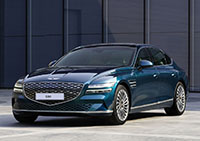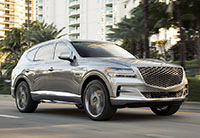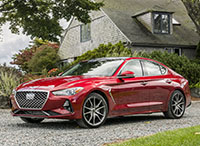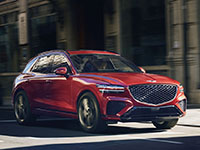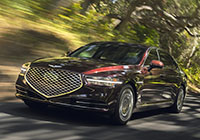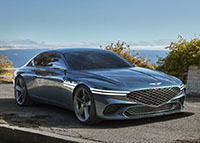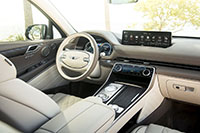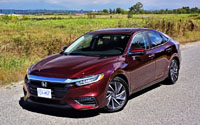
After first spending a week with Honda’s then-new Insight in its top-line Touring trim a couple of years ago, I really felt the Japanese automaker had a winner on its hands.
The compact sedan’s conservative good looks should have appealed to an even greater number of consumers than the edgier Civic it shares underpinnings and hard points with. Even better (to my eyes at least), its classy front fascia pulled some grille details over from the larger Accord mid-size sedan, while its tidier taillights stopped short of wrapping overtop most of the trunk lid.
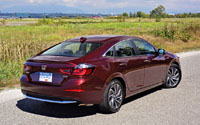
Don’t get me wrong, as the outgoing Civic was a styling tour de force when it arrived in 2015 as a 2016 model, but the more subdued Insight gave… ahem… insight to the Civic’s future design direction, particularly at the hind end where those just-noted taillights look like positive precursors to those on the much more conventional 2022 Civic sedan.
Still, as it was and still is, Honda failed to properly launch this 2019–present Insight within Canada, where it suffers incredibly slow sales, not even surpassing 500 units last year. In fact, the dismal number was 496, while the first quarter of 2021 has seen just 91 examples roll out of Honda showrooms. When compared to the Civic’s class-leading 50,805 sales-total in 2020, and 7,158 units delivered during Q1 of this year, which puts the Insight just under 1 percent of Civic deliveries during 2020, and nearly 1.3 percent for Q1 of 2021, Honda’s dedicated compact hybrid can only be seen as a complete dud. But why?
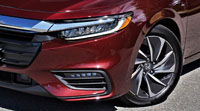
After all, the two models’ sales ratio in the U.S. is much better, although still not anywhere near as evenly weighted as I initially expected, with the Insight finding 15,932 buyers south of the 49th in 2020, and 3,859 as of the end of March this year, compared to 261,225 Civics sold last year and 55,903 for Q1 of 2021. That represents 6.1 percent of Civic sales in 2020 and 6.9 percent for the first three months of 2021, which probably isn’t even good enough to justify any sort of business case for keeping the model alive.
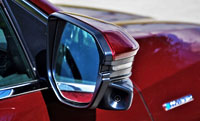
It comes down to pricing. With a base price of $28,490 (plus freight and fees), the Insight finds itself $3,400 more expensive than the Toyota Corolla Hybrid, which starts at only $25,090. If the Insight were 10-percent more car it might make sense, but, as I already pointed out, consumers have spoken load and clear with their wallets, plus I’ve personally driven both, and that’s not the case.
My Insight tester’s top-line Touring trim was even pricier at $32,190, and once again it wasn’t any more appealing than the top-tier Corolla Hybrid with its Premium package, which costs just $27,090. This means Canadian Insight Touring buyers will need to take a $5,100 hit just to see a stylized “H” badging in all the usual places, a questionable bonus they obviously don’t desire all that much.

So why would Honda sabotage its chances of winning over important Canadian hybrid buyers just ahead of the entire market turning to electric vehicles (whether we want to or not)? Obviously, Honda’s Canadian division would love to import the Insight (or for that matter the CR-V Hybrid, which is currently not available here) for less money, but their American affiliate that produces it, can’t seem to make it cheap enough.
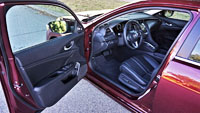
Honda does bring us the Accord Hybrid, however, but the Marysville, Ohio-built mid-size sedan doesn’t do as well as Toyota’s Camry Hybrid for similar reasons. Its base price is $35,805, whereas the Camry Hybrid is advertised at $30,790, and similarly to the Insight’s fancier Touring trim line, the top-level Accord Hybrid Touring starts at a lofty $42,505, which compares poorly to a fully loaded Camry Hybrid XLE that’s priced at only $39,690.
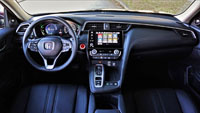
It doesn’t take a economics major to figure out that Honda Canada needs to deal with this problem if it wants to grow hybrid sales, but so far no Alliston assembly plant upgrades have been announced. If Honda Canada were able to produce the CR-V Hybrid north of the 49th, it might be able to compete with Toyota’s RAV4 Hybrid (although not the plug-in RAV4 Prime) or Hyundai’s new Tucson Hybrid, but coming up with a business case to put such a plan into action might not make any sense in our market, which is just 10 percent of America’s population.
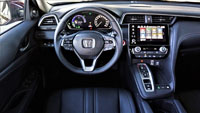
Even if such a plan made sense, the very fact Honda’s Insight is a dedicated hybrid with a number of totally unique body panels and trim, puts the smaller of these two Japanese automakers at another disadvantage. Where Toyota can theoretically produce its Corolla Hybrid at multiple plants without modifying major body stamping equipment, Honda would need to upgrade more than just the drivetrain portions of any alternative assembly plants to allow for more Insight production.
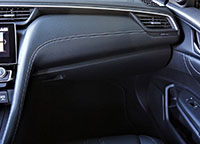
Currently, the Insight is built at Honda Manufacturing of Indiana in Greensburg, which also produces the Civic and previously pushed out the popular Civic Hybrid. If, alternatively, Honda chose to create a hybridized version of the new Civic, its many global assembly plants that are already pushing out versions of its venerable compact sedan could adapt more easily to hybrid production. Applying this (admittedly theoretical) logic to Canada’s Alliston assembly plant, might mean a Civic Hybrid could be built for Canadian consumption, thus resolving Honda’s inability to move many Insights in the great white north. As it is, Honda is fast losing its electrification edge in our market.

All said, is the Insight any good? Absolutely. If you’ve made it this far into this review, you’ll already know this Insight is nothing less than a gussied up Civic sedan, which everyone should appreciate is a very good compact car. It’s so good in fact, it consistently outsells every other car made, and we should all remember that the audience is always right (at least by “Who Wants To Be A Millionaire” standards).
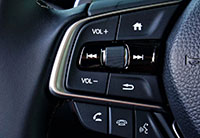
Behind its large, blackened grille opening is Honda’s well-proven 1.5-litre Atkinson-cycle internal combustion engine (ICE) and electric motor assistant, the latter powered by a 60-cell lithium-ion battery. All totalled up, the combination makes 151 net horsepower and an even stronger 197 lb-ft of torque. While off-the-line performance and passing power is certainly important, in the Insight’s compact class, hybrids are more about fuel economy, and the Insight delivers with a claimed rating of 4.6 L/100km city, 5.3 highway, and 4.9 combined, which will be good enough to wow most Civic owners that can only manage to eke out 7.9 L/100km in the city, 6.1 on the highway and 7.1 combined when driving the model’s most efficient variant. Still, Toyota’s previously noted Corolla Hybrid is not only less expensive at the time of purchase, but keeps giving at the pump with an estimated rating of 4.4 L/100km in the city, 4.5 on the highway and 4.5 combined. Ouch!
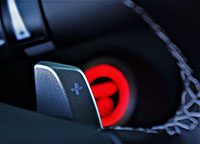
Still, a small number of Canadian consumers, who are faithful to Honda and therefore willing to pay more initially and continually, choose the Insight over the Corolla Hybrid, or for that matter the all-new Hyundai Elantra Hybrid, which incidentally improves on both Japanese models’ fuel economy thanks to a claimed rating of 4.5 L/100km in the city, 4.2 on the highway and 4.4 combined, plus adds insult to injury with a starting price of just $24,699 and arguably more attractive (or at least fresher) styling. So, for those willing to pay more for less of what hybrids are supposed to be about, the Insight delivers extremely smooth operation from its continuously variable transmission (CVT), an equally calming ride and a well-organized, reasonably high-quality interior.
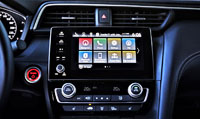
Before delving into the latter, the just-noted CVT isn’t designed for performance enthusiasts, so Civic Si buyers need not apply, but rather becomes annoyingly buzzy when pushing hard on the throttle for extended periods. Of course, such driving negates the car’s purpose, so I can’t see many Insight buyers doing so very often. I merely did for testing purposes, and have long experienced similar results from other CVT-equipped models in the class, such as the Corolla Hybrid. Nevertheless, despite its economy-first mission, Honda decided to include a Sport setting along with its expected Comfort, Econ and EV powertrain modes, which really says a lot about the much-loved brand itself.
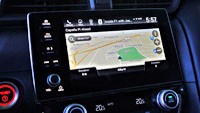
Another positive advantage benefiting Insight buyers over those living with a Corolla Hybrid, is an EV mode that allows traveling at posted city speeds, something not possible in any non-plug-in Toyota hybrid that engages its ICE over 20 km/h. While enjoyable to run around town in near silent bliss, this feature doesn’t necessarily aid fuel-efficiency, as pointed out earlier, so it won’t like matter to most buyers.
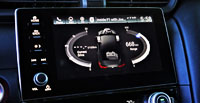
As for that smooth suspension, it really is good. My city’s streets are mostly agreeable, although like in any urban area there are roadways that desperately need upkeep and only limited funds and workers to maintain them. Despite its compact size, the Insight’s relatively long wheelbase and nicely tuned fully independent suspension made bumpy patches of tarmac easier to endure, while simultaneously providing capable road-holding when choosing to rev out its noisy powertrain. Fortunately, the much of the Insight’s motive mass hides below the rear seat, which aids its centre of gravity, providing decent handling characteristics. Again, Civic Si enthusiasts need not apply, but hybrid buyers would be pleasantly surprised if they chose to test one out.
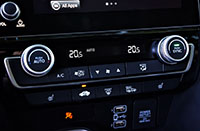
For such situations, the aforementioned Sport mode is ideal, enhanced by the ability to use steering wheel-mounted paddles to shift its CVT through a number of artificially stepped “gears”. Those who prefer shifting with a traditional gear lever are out of luck, because Honda infused the Insight’s lower console with its pushbutton gear selector. I’m just fine with that thanks to those paddle-shifters, and honestly, I only used the latter for one short stint throughout my weeklong test, due to the harshness of the drivetrain when doing so. Again, while its cool that Honda added DIY paddles, they’re not all that useful in a car like this, making me wonder if the investment might have been better spent on something else, or possibly eliminated altogether in order to lower the price?
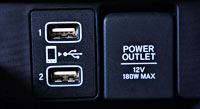
As for the pushbutton (and pull-tab for reverse) gear selector, it looks appropriately modern and frees up arm space above the console, which otherwise is fitted with a big rubberized tray for holding your oversized smartphone. Honda includes two USB charge points plus a 12-volt power supply just above, all of which come together at the base of a centre stack that’s also laid out well, with a stylish dual-zone auto HVAC interface, a slim strip of switchgear for turning on the three-way heated front seats, recirculating air, and defog/defrost functions.
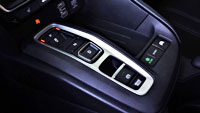
The centre stack is topped off with a large enough 8.0-inch touchscreen, which will be all-too familiar to current Civic owners. It features colourful, user friendly digital controls that are organized in an attractive tile design, with some of its functions being Apple CarPlay and Android Auto smartphone connectivity, a navigation system (in my Touring tester) that proved very accurate, a fun-to-watch engine/battery power flow indicator, audio functions for a great sounding stereo, and the list goes on.
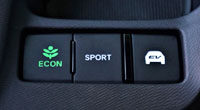
Of course, the display uses smartphone- or tablet-like finger gestures, so you can tap, swipe or pinch to your heart’s content, while Honda also framed this touchscreen with some useful switches for accessing key info quickly. The left-side row features a button for the home screen, plus one for returning back to the previous function, and another for transitioning between day and night modes. There are also two for browsing radio stations or MP3 tracks, while a rotating volume knob joins a volume controller on the left-hand steering wheel spoke. All of the infotainment system’s quick-access buttons receive backlit names just underneath, but makes sense until using them at night, when pressing the lighted name does nothing at all. Instead, you need to press the little, narrow button on top of the name, which is invisible in the dark. Yah, not the smartest application of an otherwise intelligent concept.
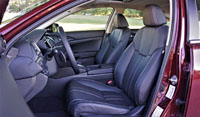
The Insight’s primary instrument experience is all positive, on the other hand. Honda was early to adopt a fully digital driver’s display, the arching cluster incorporating a multi-information display (MID) featuring useful hybrid info, such as a battery charge indicator, on the left, and a speedometer and gas gauge combo to the right. Well-made, smartly organized steering wheel switchgear controls the MID, which is par for the course with Honda products. Above everything is an overhead console integrating two incandescent reading lights, plus an emergency assist button, a HomeLink remote garage door opener, and the usual powered moonroof rocker switch. And yes, I would have rather seen an oversized glass sunroof in place of the Insight’s smallish opening, but some electrified cars don’t offer sunroofs at all, so I’d best not complain.
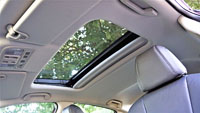
Back to positives, the Insight’s cabin approaches Acura ILX levels of fit, finish, and materials quality, with a dash top surfaced in nice pliable composites, plus a padded and French-stitched leather-like bolster ahead of the front passenger that flows across the instrument panel and down the sides of the centre stack. Certainly, I would’ve appreciated if Honda had finished the driver’s compartment as nicely as the front passenger’s, but at least both sides of the lower console gets the same soft-touch pampering treatment, which perfectly matches the sliding armrest in the middle.
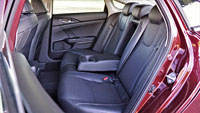
The front door uppers get the same premium covering as the dash top, by the way, while the door inserts just below receive a similar stitched leatherette to that on the instrument panel bolster. Most everything looks and feels like it was produced by an entry-level luxury brand, like Acura, but I should say that Honda isn’t alone in raising the level of refinement in its compact models.
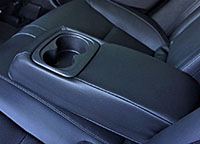
Honda has produced some of the better seats in the industry for a long time, however, and this Insight Touring’s driver’s perch is no exception. It provided excellent inherent support and no shortage of adjustability, resulting in a very comfortable office chair, while the tilt and telescopic steering column just ahead proved extendable enough to reach my shorter arms and torso when the lower cushion was pushed back far enough to make room for my longish legs. This ideal driver setup is not always possible from other compact models, and would be something I’d be willing to spend hundreds if not thousands for, so kudos to Honda for getting this right.
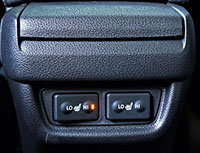
Along with excellent positioning, my tester’s steering wheel rim felt nice and meaty, with comfortable indents for thumbs and an overall performance-oriented feel. It’s as if Honda pulled it out the aforementioned Civic Si, rather than something designed to blissfully cruise past gas stations. All-round, the cockpit area is comfortable, spacious and lends a sense of control, which is exactly what most in this class are looking for.
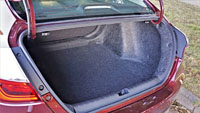
Rear passengers should be nearly as comfortable, and despite not covering the tops of each window sill with soft-touch synthetic like those up front, the rest of the door panels were near duplicates, and a reasonably large armrest topped off by unreasonably small cupholders made things comfier for those stuck in back. Likewise, two-way rear seat warmers added wintertime heat to the outboard cushions, but there were no air vents next to the rocker switches on the backside of the front console or anywhere else in back, nor for that matter reading lights overhead.

The trunk’s 416-litre (14.7 cu-ft) volume should be large enough for most peoples’ needs, while extra gear can be placed below the cargo floor if small enough. This is where Honda stows the Insight’s tire repair pump, which is necessary for fixing a flat, being that no spare is offered. Expanding on the trunk’s usefulness are 60/40-split rear seatbacks, and no centre pass-through for loading longer items such as skis down the middle.

If an Insight seems like the car for you, keep in mind that Honda is currently offering up to $1,000 in additional incentives. You can learn more about this discount on our 2021 Honda Insight Canada Prices page, which also provides comparative trim pricing, plus the ability to build the car with all available options. While you’re there, be sure to check out how the CarCostCanada system works, so you can utilize dealer invoice pricing to save even more when negotiating your best deal, plus download the free CarCostCanada app so you can have all of this valuable information on-hand when you need it most, whether at a Honda dealership pushing for a more agreeable Insight price, or walking across the street to a Toyota or Hyundai dealer in order to check out their electrified Corolla and Elantra offerings.
Review and photos by Trevor Hofmann

